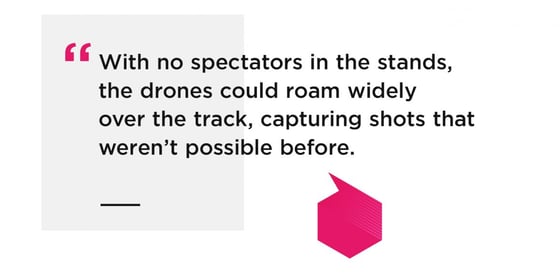While every business has been touched by the pandemic, Hollywood’s entertainment production industry has found itself struggling to safely resume work even as the demand for its products soar. One result: a boom in the use of drones for handling socially distanced camerawork in ways that were once unheard of.
Drones Transform Film Production
From music videos to fashion shoots and commercial production, drones have become more common on the sets of many productions, says Beverly Hills Aerials founder and chief drone operator Michael Izquierdo. Launched five years ago, Izquierdo says his firm has seen demand rapidly increase in the past few months since drones can produce professional-grade camerawork with a minimum of staff.
“In this climate, it’s difficult to do a standard shoot with 15 crew members, which is how we did things before COVID,” he says. “Now, we can go out with one person, literally be hundreds or even a thousand feet away, and still get the same kind of shots as producers expected before.”
Izquierdo has worked with DJI’s drone technology for years, using off-the-shelf craft and DJI components to build custom aerial solutions, such as a heavy lift drone to provide high-quality camera footage during the races. But the challenges of the pandemic also led to enhancements of camera quality of high-speed racing drones to provide a better image quality to the audience.
Catching the Action from Above
Sports have been especially hard hit by the pandemic, with many major leagues going to such extremes as locking players and support crew inside virtual “bubbles” in bids to restart competition while remaining safe. One of the first sports leagues able to return was NASCAR, which was able to safely hold races without fans this spring.
After several trials, Fox Sports reached out to Izquierdo with a challenge: How could his company’s drones improve live broadcast coverage of a race, especially one where fans could only attend from their living room televisions?
Drones are great for capturing video; DJI has even won an Emmy for its technical innovations in Low Latency Remote Controlled Airborne Video Platforms for Television. But a high-definition, live-broadcast camera requires a much higher level of control, customization, and connectivity than many off the shelf drone systems can provide.
“A director of a live sports event wants to paint the picture in real-time and needs the ability to change all kinds of camera settings on the fly,” Izquierdo said. “That’s a big deal.”
The Perfect NASCAR Drone
To meet the challenge, Izquierdo turned to his research bench to modify his fleet. His DJI-powered FPV drone can hit speeds of 80 mph with a top speed of 100 mph, navigated with a headset that mirrors the drone’s first-person camera. With no spectators in the stands, the drones could roam widely over the track, capturing shots that weren’t possible before. And the DJI controllers allowed for camera changes at high speeds while the drone is in the air.
The results have been impressive enough that Fox Sports created its own “Drone Cam” logo for shots from the cameras, and while the range may decrease once fans can attend again, the reception has been positive.
“Being able to do all of this has been awesome,” Izquierdo says.
A New Perspective on Entertainment
Beyond racetracks, DJI expects its drones to find increasing use in entertainment production, as they demonstrate their value not just for safety reasons but artistic and financial ones as well.
“The pandemic has shown the viability and importance of drone technology in sports, film production, and entertainment,” said Stuart Cram, DJI’s marketing liaison with the film and television community. “Now that the genie is out of the bottle, and audiences grow accustomed to the high-quality footage that they’re currently providing during the pandemic, we expect to see many more creative use cases in all sorts of sectors. Our only limitation will be our imagination.”

